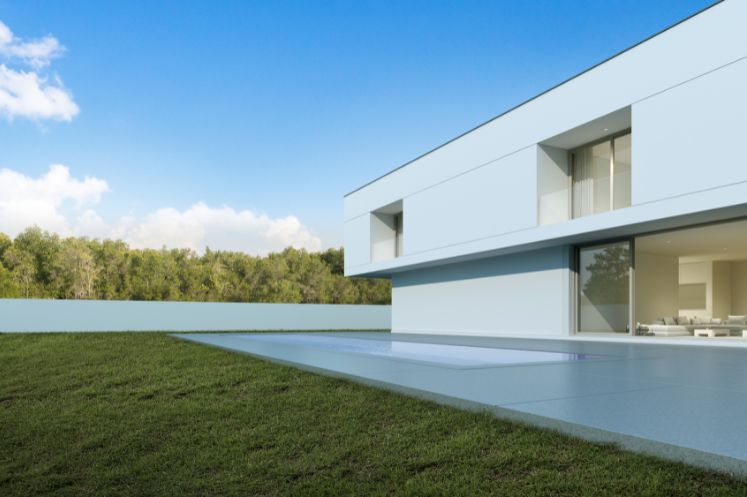Modern architecture has revolutionised the way we conceive and inhabit spaces. Since the early 20th century, this movement has marked a significant shift in architectural design, driving new ideas and concepts that have endured to this day. Below, we explore the key elements that define modern architecture.
Functionalism
Design principle
One of the pillars of modern architecture is functionalism, which holds that the form of a building should be determined by its function. Each architectural element should fulfil a specific function, avoiding unnecessary decoration. This principle translates into a practical approach, where spaces are designed to meet the needs of their users in an efficient manner. This means that each area of the home or building has a clear purpose, which maximises the usefulness of the space.
Examples of functionalism
Outstanding examples of this trend can be found in works by architects such as Le Corbusier and Ludwig Mies van der Rohe, whose creations reflect this approach. Buildings such as the Villa Savoye or Mies’ German Pavilion are iconic representations of how functionalism translates into architectural design, emphasising the relationship between space and its practical use.
Contact our architectural firm
Simplicity and Minimalism
Clean aesthetics
Simplicity is another fundamental characteristic of modern architecture. It moves away from the ornamental styles of the past, advocating clean lines and simple forms. This approach seeks to reduce visual complexity, emphasising the essence of the space. Modern architects employ a neutral colour palette and materials that allow the structure to speak for itself, creating a more serene and harmonious environment.
Impact on interior design
Minimalism not only applies to exterior architecture, but also influences interior design. Uncluttered spaces, functional furniture and austere decoration are principles that create cosy and orderly environments. This contributes to a sense of peace and well-being, which is essential in modern life, where the hustle and bustle of everyday life can lead to stress.
Use of New Materials
Innovation in construction
Innovation in construction has been crucial in modern architecture. The use of new materials, such as reinforced concrete and steel, has made it possible to create lighter and stronger structures. These materials not only offer greater durability, but also allow for bolder designs, challenging the limitations of traditional architecture.
Windows and facades
The incorporation of large windows and glass facades maximises natural light and connection to the outside environment. This approach not only improves the aesthetics of buildings, but also promotes a healthier indoor environment, as natural light has positive effects on the mood and productivity of occupants.
Open Design
Fluid spaces
Open plan design is another distinctive feature of modern architecture. This approach promotes fluid and flexible spaces, eliminating unnecessary walls and creating a sense of continuity between different areas. The elimination of physical barriers allows for more fluid interaction between inhabitants, facilitating coexistence and communication.
Benefits of open design
The idea is to encourage social interaction and functionality, allowing the inhabitants to move freely through the space. This design is especially useful in family homes, where the connection between the kitchen, dining room and living room can improve family dynamics, creating a more welcoming and collaborative environment.
Integration with the Environment
Relationship with nature
Modern architecture is concerned with integration with the environment. Architects seek to create buildings that adapt to the landscape and climate, respecting nature and making the most of its resources. This practice not only ensures that structures are sustainable, but also promotes harmony between man and nature.
Sustainable projects
This relationship with the environment not only enhances sustainability, but also enriches the user experience. Buildings that incorporate natural elements, such as vertical gardens or green roofs, not only contribute to aesthetics, but also improve air quality and provide recreational spaces for residents.
Technological Innovation
Advances in design
Finally, technology plays a vital role in modern architecture. From the use of advanced design software to the implementation of prefabricated building systems, technology has expanded the possibilities of design and construction. Architects can now visualise their ideas more accurately and make modifications in real time.
Advanced materials
The incorporation of smart building technologies, such as home automation systems, is also becoming a standard in modern architecture. These systems not only improve energy efficiency, but also give residents full control over their environment, allowing for intuitive adjustments to temperature, lighting and security.
Intelligent construction
Smart building is increasingly being integrated into architectural projects, allowing buildings to be more sustainable and adaptable to users’ needs. This trend is leading modern architecture towards a future where functionality and technology coexist harmoniously.
At Velló Monfort Arquitectes, we specialise in applying the principles of modern architecture to our projects, creating functional and aesthetically pleasing spaces that adapt to the needs of our clients. With a focus on sustainability and innovation, we are committed to designing new works that not only respect the environment, but also improve the quality of life of its inhabitants. If you are interested in exploring how modern architecture can transform your home, we invite you to take a look at our new build projects and discover the vision we can offer you.


